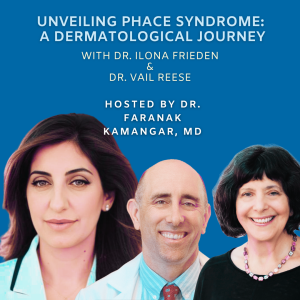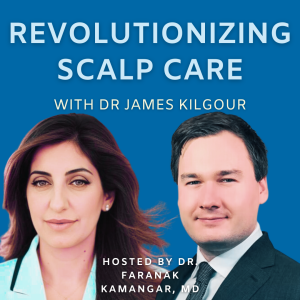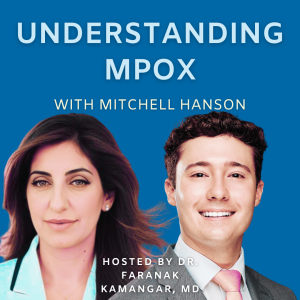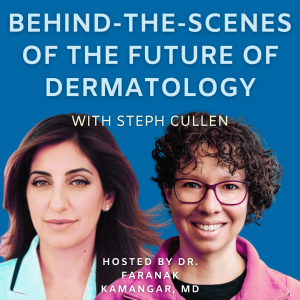The Future of Dermatology
Join Dr. Faranak Kamangar, MD, every week as she chats with various guests about the future of dermatology. Each week, Dr. Kamangar and her guests cover topics from psoriasis, to eczema, to skin care, to AI, and more. Whether you’re a doctor or a patient, these episodes provide valuable information about your skin and how to navigate the world of dermatology.
Episodes

Tuesday Feb 11, 2025
Tuesday Feb 11, 2025
Summary
In this conversation, Dr. Ilona Frieden and Dr. Vail Reese discuss the origin and significance of PHACE syndrome, a condition characterized by facial hemangiomas and neurological abnormalities. They share their experiences in identifying and naming the syndrome, the importance of collaboration in medical research, and the future of dermatology in understanding genetic conditions. The discussion highlights the role of dermatologists in recognizing and describing new syndromes, the impact of acronyms in medical education, and the ongoing research into the causes and implications of PHACE syndrome.
To read Dr. Frieden and Dr. Reese's original article, visit: https://pubmed.ncbi.nlm.nih.gov/8607636/
Takeaways
Dr. Frieden has over 35 years of experience in pediatric skincare.
The origin of PHACE syndrome began with a unique patient case.
Collaboration among dermatologists is crucial for medical advancements.
Acronyms can aid in memorizing complex medical conditions.
PHACE syndrome includes various components beyond hemangiomas.
Research continues to explore the genetic basis of PHACE syndrome.
Patient advocacy groups play a vital role in supporting affected families.
Dermatology is evolving with advancements in genomics and technology.
Understanding regional aspects of disease can lead to new insights.
The future of dermatology is promising with ongoing research and discoveries.
Chapters
00:00 - The Origin of PHACE Syndrome07:37 - Understanding the Components of PHACE Syndrome14:30 - The Significance of Acronyms in Medicine20:00 - The Future of PHACE Syndrome and Dermatology

Tuesday Feb 04, 2025
Tuesday Feb 04, 2025
Summary
In this episode of the Future of Dermatology podcast, Dr. Faranak Kamangar and Dr. Amit Pandya delve into the complexities of vitiligo, a pigmentary disorder. They discuss the importance of shared decision-making in patient care, the various treatment options available including systemic therapies and phototherapy, and the future of vitiligo treatment with emerging therapies like JAK inhibitors. Dr. Pandya emphasizes the need for personalized treatment plans based on patient preferences and the significance of monitoring progress through regular check-ups and photographs. The conversation highlights the exciting advancements in vitiligo treatment and the hope for better management strategies in the future.
Takeaways
Shared decision making is crucial in vitiligo treatment.
Understanding the extent and location of lesions is key.
Systemic therapies like dexamethasone are commonly used.
Phototherapy is essential for managing vitiligo.
Long-term management requires regular follow-ups and monitoring.
Emerging JAK inhibitors show promise for future treatments.
Patient goals should guide treatment decisions.
Phototherapy can prevent new lesions from forming.
New therapies aim to stimulate melanocyte repigmentation.
The field of vitiligo treatment is rapidly evolving.
Chapters
00:00 - Introduction to Dermatology and Vitiligo01:30 - Understanding Patient Perspectives in Vitiligo Treatment05:00 - Exploring Systemic Therapies for Vitiligo09:52 - The Role of Phototherapy in Vitiligo Management12:14 - Long-Term Management of Vitiligo Patients14:42 - Future Directions in Vitiligo Treatment

Tuesday Jan 28, 2025
Tuesday Jan 28, 2025
Summary
In this episode of the Future of Dermatology podcast, Dr. Faranak Kamangar interviews Dr. Hannah Kopelman, a dermatology resident specializing in hair loss, skin cancer, and teledermatology. They discuss Dr. Kopelman's journey into dermatology, the emotional impact of hair loss on patients, and the innovative teledermatology platform she co-founded. The conversation also covers treatment approaches for hair loss, the importance of fellowship training, and exciting future developments in dermatology, particularly in hair research.
Takeaways
Dr. Kopelman has a passion for dermatology from a young age.
Hair loss significantly affects both men and women emotionally.
The Derm Club podcast fills a void in dermatology education.
Teledermatology provides essential access to care for patients.
Understanding patient expectations is crucial in hair loss treatment.
Starting treatment with one medication helps monitor side effects.
Fellowship training enhances specialized skills in dermatology.
Empathy is key in managing patients with hair loss.
Future research may revolutionize hair restoration techniques.
The future of dermatology holds exciting advancements in hair care.
Chapters
00:00 - Introduction to Dermatology and Guest Introduction03:11 - Dr. Hannah Kopelman's Journey in Dermatology06:03 - The Impact of Hair Loss and Patient Care08:54 - Teledermatology: Bridging Gaps in Access12:13 - Approaches to Treating Hair Loss15:01 - Fellowship Training and Future Aspirations17:53 - The Future of Dermatology and Hair Research

Tuesday Jan 21, 2025
Episode 70 - Revolutionizing Scalp Care | The Future of Dermatology Podcast
Tuesday Jan 21, 2025
Tuesday Jan 21, 2025
Summary
In this episode of The Future of Dermatology Podcast, Dr. Faranak Kamangar interviews James Kilgour, a dermatology resident at Stanford and the founder of KilgourMD. They discuss James's journey from the UK to California, his experiences in dermatology, and the innovative skincare line he developed for scalp health. The conversation delves into the importance of understanding the environmental factors affecting hair loss, the need for a skincare regimen for the scalp, and the future of treatments like PRP in dermatology.
Takeaways
James Kilgour's journey from the UK to Stanford highlights the importance of mentorship.
The concept of treating the scalp like facial skin is revolutionary.
Environmental factors play a significant role in hair loss.
Patients often seek alternatives to traditional hair loss treatments like minoxidil.
Regenerative medicine is becoming a focal point in dermatology.
Understanding the microenvironment around hair follicles is crucial for treatment.
Skincare products are essential for both cosmetic and health reasons.
The need for a comprehensive approach to scalp health is unmet in current dermatology practices.
PRP shows promise in hair restoration and scalp health.
Innovation in dermatology is driven by patient needs and scientific research.
Chapters
00:00 - Introduction to the Future of Dermatology Podcast01:51 - James Kilgour's Journey in Dermatology04:15 - The Birth of KilgourMD07:56 - Understanding Scalp Health and Environment10:14 - Innovative Approaches to Hair Loss Treatment14:00 - The Future of Dermatology and PRP

Tuesday Jan 14, 2025
Episode 69 - Understanding MPOX | The Future of Dermatology Podcast
Tuesday Jan 14, 2025
Tuesday Jan 14, 2025
Summary
In this episode of the Future of Dermatology podcast, Dr. Faranak Kamangar speaks with Mitchell Hanson, a medical student and researcher, about the intersection of dermatology, sexual health, and public health. They discuss the importance of modernizing sexual health history taking, the impact of MPOX on sexual and gender minorities, and the role of trust in patient care. The conversation also highlights the significance of vaccination efforts and the integration of art and advocacy in dermatology. Mitchell shares his vision for the future of dermatology, emphasizing the need for effective communication and engagement with the public through media.
Articles mentioned in this podcast:
https://practicaldermatology.com/topics/feature/advancing-sexual-health-histories-in-dermatology-a-modernized-comprehensive-approach-for-diverse-populations/28864/ https://www.greaterthan.org/campaigns/mpox/https://www.nejm.org/doi/full/10.1056/NEJMp2407068
Takeaways
Dermatology has deep roots in public health and sexual health education.
Building trust with patients is essential for effective care.
Modernizing sexual health history taking is crucial for accurate diagnoses.
MPOX has significant implications for sexual and gender minorities.
Vaccination efforts are vital in controlling public health threats like MPOX.
Art can serve as a powerful tool for advocacy in dermatology.
Health equity must be prioritized in dermatological practices.
Education is key to dispelling misinformation about vaccines.
Engaging with media can enhance public understanding of dermatology.
The future of dermatology lies in innovative ideas and community involvement.
Chapters
00:00 - Introduction to Dermatology and Guest Background02:48 - The Importance of Sexual Health in Dermatology05:59 - Building Trust with Patients09:08 - Modernizing Sexual Health History Taking11:46 - Understanding MPOX and Its Impact14:56 - Clinical Presentation and Diagnosis of MPOX18:09 - Public Health Response and Vaccination Efforts20:56 - Art and Advocacy in Dermatology23:46 - Future of Dermatology and Media Engagement

Tuesday Jan 07, 2025
Tuesday Jan 07, 2025
Summary
In this episode of the Future of Dermatology podcast, Dr. Zakia Rahman, MD, discusses the advancements in laser treatments for dermatological conditions, particularly focusing on acne scarring. The conversation covers the differences between ablative and non-ablative lasers, their applications, and the importance of understanding patient healing processes. The episode also highlights the success of the SF Derm 2024 meeting and encourages listeners to engage with the podcast community.
Takeaways
The SF Derm 2024 meeting was a significant event for dermatologists.
Fractional lasers utilize surrounding normal skin for effective treatment.
Acne scarring is prevalent, especially in certain ethnic groups.
Active acne must be treated before addressing scarring.
Non-ablative lasers can be effective for various skin types.
Ablative lasers require careful consideration of downtime and healing.
Skin healing varies significantly among patients.
FDA clearance for lasers includes treatment for vascular lesions.
Engagement with the audience is crucial for podcast growth.
Medical advice should always come from a qualified doctor.
Chapters
00:00 - Introduction to the Future of Dermatology Podcast01:00 - Understanding Laser Treatments in Dermatology04:13 - Addressing Acne Scarring and Treatment Modalities07:05 - Ablative vs Non-Ablative Laser Treatments

Thursday Jan 02, 2025
Thursday Jan 02, 2025
Summary
In this episode of the Future of Dermatology podcast, Dr. Faranak Kamangar welcomes back Dr. Nahid Vidal to discuss her experience at the ASDS Iron Surgeon Competition. They delve into the creative process behind Dr. Vidal's entertaining video presentation, the balance between professionalism and creativity in the medical field, and the joy of participating in such a unique event. Dr. Vidal shares insights on the importance of community and the positive impact of creativity in dermatology, as well as her reflections on the future of her career and the field.
Watch Dr Nahid Vidal's epic music video here: https://youtu.be/5oYTc2YKa3M?si=qovWHj5clI5uOfEL
Takeaways
Dr. Vidal won the ASDS Iron Surgeon Competition, showcasing her skills and creativity.
The competition combines surgical expertise with entertainment, making it unique in the dermatology field.
Creativity in reconstructive surgery is essential and can enhance patient outcomes.
Dr. Vidal's background in making music videos contributed to her success in the competition.
The video presentation was a collaborative effort involving her family and colleagues.
Balancing professionalism with creativity is a challenge for many physicians.
The joy and camaraderie among colleagues were evident in the video and during the competition.
Dr. Vidal aims to inspire others in the field through her creative endeavors.
Participating in the competition was an honor and a fun experience for Dr. Vidal.
The future of dermatology may benefit from more creative and entertaining approaches.
Chapters
00:00 - Introduction to the Future of Dermatology Podcast00:49 - The ASDS Iron Surgeon Competition04:07 - Creative Process Behind the Competition Video10:57 - Balancing Professionalism and Creativity17:59 - The Day of the Competition23:53 - Reflections on the Experience and Future Aspirations

Tuesday Dec 24, 2024
Tuesday Dec 24, 2024
Summary
In this episode of The Future of Dermatology podcast, host Dr. Faranak Kamangar and, podcast producer Steph Cullen, discuss the behind-the-scenes workings of the podcast, the importance of nonprofit organizations, and the educational and mentorship roles within the field. They explore the impact of media on dermatology, the depth of the specialty beyond cosmetic procedures, and future topics for the podcast, including tattoos and their effects on skin health.
Takeaways
The Future of Dermatology Podcast aims to educate and inform about various dermatological topics.
Nonprofits play a crucial role in enhancing community health and awareness in dermatology.
Media production is essential for nonprofits to gain exposure and support.
Education and mentorship are vital components of the dermatology community.
The podcast has evolved to include virtual conferences and a wider audience.
Dermatology encompasses much more than just cosmetic procedures like pimple popping.
The passion of dermatologists for their field is evident in their discussions.
Future podcast topics may include tattoos and their implications for skin health.
The importance of community and collaboration in dermatology is emphasized.
The podcast encourages participation and feedback from its audience.
Chapters
00:00 - Introduction to the Future of Dermatology Podcast01:52 - Behind the Scenes with Stephanie07:58 - The Impact of Nonprofits in Dermatology10:53 - Education and Mentorship in Dermatology18:02 - The Role of Media in Dermatology22:17 - Exploring the Depth of Dermatology23:38 - Future Topics for the Podcast







